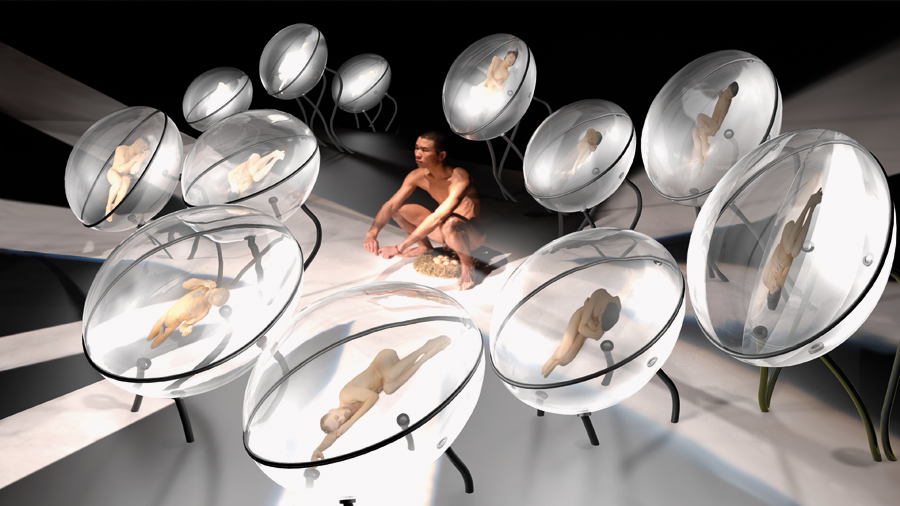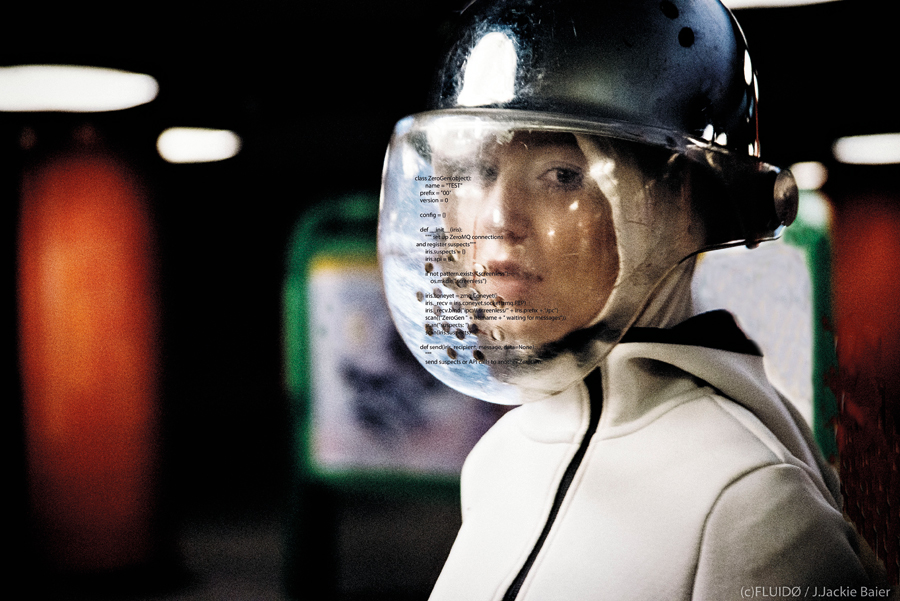‘Society Has Become the Biggest Panopticon’: An Interview with Shu Lea Cheang
The queer cyberfeminist pioneer’s Taiwan Pavilion in Venice explores surveillance, pleasure and control
The queer cyberfeminist pioneer’s Taiwan Pavilion in Venice explores surveillance, pleasure and control

I first met Shu Lea Cheang in the summer of 2011 at Medialab-Prado in Madrid. We were taking part in a residency on the theme of ‘devisualize’, which aimed to resist digital control technologies and push back against the god-trick of software visualization. During the residency, a manifesto was collectively written that called for a post-anatomical body and the reconfiguration of visibility in technical systems. In the lab, amid 3D printers, naked performers and hacked computers, Shu Lea and I were at work on new projects. I was just starting the first prototypes of what would become my ‘Facial Weaponization Suite’ (2011–14): a series of masks that thwart biometric facial recognition technologies. Shu Lea had a frenetic team of young queers and techies about her as they worked relentlessly on UKI (2009–14), a game and performance about queer infiltration and viral outbreaks.
I had studied Shu Lea’s work as an art student: experiencing her early web-based piece Brandon (1998–99) was a revelation to me. In person, I was mesmerized by Shu Lea’s energy and commitment: her entwining of life, art and politics was striking. Shu Lea is a – if not the – pioneer of queer new media art and her practice taught me early on that digital art does not have to be a wasteland of patriarchal hetero male sensibilities. Over the years, we’ve found oursleves showing work alongside one another in numerous festivals and exhibitions – from transmediale in Berlin to the Institute of Contemporary Arts in London and the Gwangju Biennale. It is a true, deep pleasure to be friends and queers together.

Zach Blas You’re currently making new work for the Taiwan Pavilion at this year’s Venice Biennale. I understand ‘3×3×6’ will be a partial reimagining of Jeremy Bentham’s panopticon, focusing on persons criminalized for acts of sexual deviancy. The title references the standardized architecture of industrial imprisonment: a three-square-metre cell constantly monitored by six cameras.
Shu Lea Cheang The panopticon was a starting point. In Venice, the Taiwan Pavilion is in the Palazzo delle Prigioni, a 17th-century prison complex that is connected to the Palazzo Ducale by the Bridge of Sighs. I was interested in digging into this history.
Already in Brandon [a web-based work that explores the life of Brandon Teena, a trans man who was raped and murdered in the US in 1993], I was thinking about the panopticon as a place for housing the mentally ill and ‘sexually deviant’ people. The panopticon connects Teena’s personal story to broader issues concerning the criminalization and medicalization of those considered sexually deviant. Simulations of the panopticon are overlaid with virtual prisoners and patients undergoing surgeries. I remember visiting the former Koepelgevangenis prison in Haarlem, where you can still see the architectural structure of the panopticon; but now, society itself has become the biggest panopticon. Think about data collection, facial recognition. China is boasting that it has 200 million surveillance cameras with facial recognition capacities.
ZB I read that you describe the new work as a data sexopticon?
SLC I actually called it data panopticon; the sexopticon idea came from the curator, Paul B. Preciado, which immediately got me in trouble with the museum when we were trying to submit the proposal.
ZB Your practice typically orients around technology and queer sex. Your film I.K.U. [2000], is a kind of queer Bladerunner [1982] in which replicants roam New Tokyo gathering orgasm data. With ‘3×3×6’, what do you aim to express about queer sex and surveillance today?
SLC If you Google ‘Palazzo delle Prigioni’, the first thing you come across is that Giacomo Casanova was imprisoned there in the 18th century. That was the starting point. From there, Paul and I did research into ten particular cases – some historical and some contemporary – where people have been imprisoned for reasons related to sex. There’s Casanova, the Marquis de Sade, Michel Foucault and, more recently, the so-called ‘female sperm bandits’ in Africa. We co-wrote a script around each of these cases and I made short film portraits of each figure.

ZB I see similarities to Preciado’s idea of the ‘pharmacopornographic’. In Testo Junkie [2008], he compares birth control to the panopticon, evoking a biomolecular surveillance system: something that can be shrunk down into a pill or medicine and ingested. This goes against one of the key aspects of Bentham’s panopticon – that you’re physically confined to a cell. In the pharmacopornographic panopticon you may not necessarily be confined, because the regulation is of another quality.
SLC In the Taiwan Pavilion, a tower of ten projectors will be installed in one gallery, inverting the function of an operating surveillance system. There will also be a small gallery recast as the control room, which will be set up with computer monitors to expose how the surveillance system in the installation functions. We will be asking people to send in selfies. These images, as well as the 3D scans captured by the surveillance cameras will then be manipulated. It’s like in your work, where you use 3D modelling to morph facial recognition data to produce unrecognizable forms: the idea is to obscure.
ZB Don’t forget the detail that I thought was so intriguing about the control room: that it’s modelled after Hugh Hefner’s control room in the Playboy Mansion!
SLC Right.
ZB This is important because it draws attention to a gendered dynamic at play in the exhibition’s conception of surveillance, which concerns watching and desire.
SLC To obscure and revoke the omnipresent surveillance of queer bodies, we need to remodel, morph, and transpass all gender binaries. There is no ‘passing’; rather, gender and racial identities in constant flux to avoid confinement.
ZB Last autumn, at Matadero Madrid, I installed SANCTUM [2018], an immersive installation that is an amalgam of sex dungeon, detention centre, temple and munitions factory. SANCTUM was motivated by how desire complicates our relationship to surveillance apparatuses. We submit ourselves to digital devices and platforms, such as Facebook, even when we know that our data is being nefariously gathered and used – and we often take great pleasure in doing so. Uploading a selfie is a simple example. Pleasure and exhibitionism are so much a part of surveillance.
SLC I was talking to a friend who studied architecture, and he told me that Bentham designed the panopticon with one place – a slit, a little passageway – that was not observable. Now, why is it that nobody can see that particular slit? It’s a slit where people can go to masturbate.

ZB Bentham designed this in his original scheme?!
SLC I think so.
ZB He appreciated masturbation, I guess.
SLC In terms of the prisoners, pleasure is a very important point. The imagery in the ‘3×3×6’ films is fantastical; you see some of the characters masturbating. It was important to me to portray these prisoners in a different way, not only as victims. I wanted to think about how you can exist in such a system and still seek a certain kind of pleasure. I’m currently editing the footage and I realize how much pleasure I’m trying to portray.
ZB Could you talk about how you’ve cast the actors?
SLC The aim was to break down racial and gender typecasting. For example, Casanova is played by Enrico D. Wey, a Taiwanese American dancer, and the Marquis de Sade by the queer female performer Liz Rosenfeld. Both reside in Berlin, where the filming took place.
ZB Is Preciado still playing Foucault?
SLC No, he quit two weeks before the shoot. We got a French guy, Félix Maritaud, who plays the lead in the film Sauvage [Wild, 2018, which follows a young sex worker on the streets of Strasbourg]. He was also in 120 BPM [2017], a film about the AIDS crisis in 1990s Paris.
ZB I feel very connected to your mode of making: we both produce film and video but also create digital art – whether net-based, interactive or utilizing computation. Your early work was mostly in film and video, but you were also part of the first wave of net art in the 1990s.
SLC It’s almost like I have two separate worlds. In terms of cinema, I go very sci-fi – and I want to be very sexually explicit. I.K.U., for instance, I call science-fiction porn. In terms of my art career, I came out of 1980s video art and migrated into cyberspace in the 1990s, which brought me to what, today, we call digital art. I am interested in working with media technology, but I explore queer lives and sex across all these media. Yet, I always feel like talking about sex is a no-no in the gallery and museum; it always creates so much trouble for me.

ZB When you look back at that 1990s cyber-feminism moment, how close do you feel to it?
SLC I have never really felt like I fit into any particular genre of art, I must say. Even now, I don’t have a gallery, I don’t sell my work. I have a bit of an inferiority complex about not being recognized.
At the same time, I’m actually quite happy that I can continue doing porn. Last October, when I started preparing for the Venice Biennale, I got so bored with making art! So, I made a short porno called The Fisting Club, EP1, which was commissioned by London’s Boiler Room. We shot it in a day. It really helped release the tension of being an artist!
I’m still close to people from the 1990s cyberfeminism movement, like the VNS Matrix: those artists who expanded feminism to take on the web and digital technologies and find new pathways to liberation. In my work, I’m still speaking about the vagina complex and the big daddy mainframe. I feel like I am still struggling with these things. Deep down, a lot of what I am doing is about hacking the system, infiltrating. Even in terms of making porno films: it’s a way to hack into that field.
ZB What is so strong about the work is that it addresses a brutal aspect of surveillance today – that is, its far-reaching entrenchment and collusion with the incarceration of minoritarian people.
The protagonists of SANCTUM are ‘generic mannequins’, which is the corporate term for those bizarre cartoon-like figures that have their hands up on the interfaces of airport body scanners. I kept wondering: what is the afterhours world that the generic mannequin lives in? It seemed to me that it could only be a kind of double-edged type of confinement: pleasure and exposure on the one hand, and imprisonment and confinement on the other. SANCTUM insists that these can’t be disentangled in contemporary surveillance systems. I noticed that in one of your stills, perhaps from the Casanova film, there is a cage just like the one in SANCTUM. When it comes to desire, exposure and surveillance, it could be a BDSM puppy cage, a prison cell, or both.
This article first appeared in frieze issue 203 with the headline ‘Machines of Loving Grace’
Main images: 00 X from the series '3×3×6', 2019, video still. Unless otherwise stated, all images courtesy: the artist and the Taiwan Pavilion, Venice Biennale 2019























